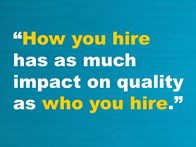 The results are in. The best way talent acquisition leaders can add value to their business is by consistently delivering quality hires. If that is our goal, it is important to know that how you hire has as much impact on quality as who you hire.
The results are in. The best way talent acquisition leaders can add value to their business is by consistently delivering quality hires. If that is our goal, it is important to know that how you hire has as much impact on quality as who you hire.
There are many methods for bringing talent into a company, but they can all be nicely grouped into two categories: direct and indirect hiring.
“Indirect hires” are typically those made by agencies. And while agencies are helpful for filling roles that are niche, extremely urgent or require nonrecurring skillsets, they should not be overly relied upon in your recruitment strategy.
Here is why.
By design, agencies are not built to be long term partners. They will not dive deeply enough to understand the culture or what it takes for an individual to thrive within an organization. Nor are they required to provide you with the best talent if another client is paying top dollar for a similar position. In short, agencies should not be overly relied upon because of their high costs and greater potential to deliver disloyal or poor quality candidates.
But there are other ways to find top talent.
“Direct hires” are individuals who are proactively contacted by your recruiters, referred by existing employees or promoted internally. And therein lies your advantage.
A Proactive Approach to Controlling Quality
Because you have more influence over direct hiring, it makes sense that individuals selected in this manner would be better suited to your organization’s culture and aligned with its goals. However, you must have a solid strategy in place to ensure this method of hiring is actually improving quality.
Setting up a Quality of Hire feedback loop – a chain of communication between executives, hiring managers and talent acquisition – makes a world of difference when it comes to finding the right people for the right roles within the organization.
Here is an example of how a Quality of Hire feedback loop will proactively influence the quality of direct hire candidates:
- Define Quality: There must be an agreed upon definition of quality hire, per measured role, within the organization. As talent acquisition leaders, we must work closely with the C-Suite and hiring managers to arrive at those definitions.
- Measure Quality: Once the definition is set for each role, we must measure employee performance against our expectations. It often takes six months to a year to gain a solid understanding of an employee’s caliber, so we need to track key performance indicators over time and adjust if necessary.
- Predict Quality: Then, we must use the data we have collected to predict how well candidates will perform when hired or promoted. Once the hire or promotion is made, we return to the measurement stage and repeat the cycle as needed – even returning to our core definitions if they have missed the mark.
With a Quality of Hire feedback loop established, your job advertisements and brand work can be more precisely targeted to an audience with the characteristics needed to be successful. This helps filter out low or average quality candidates. The recruiters will also have a thorough understanding of the role’s requirements, the wider organizational culture and access to historical data of high-performers in the roles they are hiring for.
Having these layers in place ensures only the most qualified candidates are put forward and accepted into the organization.
So the method you use to hire candidates does have an impact on Quality of Hire. You can choose to go the quick and easy route with agencies, but you risk having low quality, disloyal employees on whom you spent a disproportionate amount of money to acquire. Or, you can nurture your direct hiring and Quality of Hire programs for a more sustainable and reliable method to gain outstanding employees.
True, measuring Quality of Hire is a commitment that requires a significant time investment. But the ROI is worth substantially more than the cost. The better you become at measuring and predicting the effectiveness of individuals in key roles, the better your hires will be. If you do not have the resources to go it alone, consider finding a partner who can help.

Post contributed by Paula Parfitt, Senior Vice President. Connect with her on LinkedIn or follow her on Twitter.
